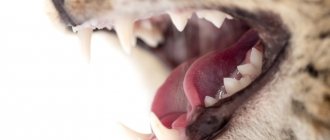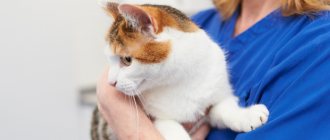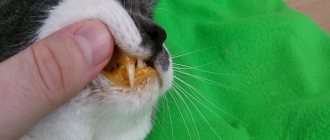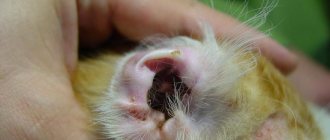Most dog owners know what ear mites (ear mites) are and how difficult it can be to fight them. The disease is called "otodectosis". It is caused by an acarimorphic mite of the species Otodectes cynotis. The parasite is indistinguishable to the eye (0.2-0.4 mm). The colony occupies the outer part of the dog's ear, right down to the membrane.
The food is skin particles (epidermis), sulfur, blood and lymph, which is obtained through punctures. The disease causes anxiety and suffering to the animal. It is dangerous for the development of serious complications and requires diagnosis and comprehensive treatment.
Causes of otodectosis in cats
Feline ear mites are a highly contagious (highly contagious) disease. Otodectosis can affect not only cats, but also dogs, arctic foxes, foxes and even rodents. Ticks are transmitted from cats to kittens and from kittens to kittens. An adult cat can also become infected with ear scabies during mating. Often, infection occurs without direct contact with an infected animal, but through contact with surfaces where ticks and/or parasite eggs can be released from the skin or ear of an infected animal.
Ear mites in a cat
Because Cat mites can cause severe itching, the animal experiences constant discomfort on the surface of the skin, shakes its ears, the causative agent of otodectosis is “shaken out” into the environment and this further contributes to the transmission of ear mites to other animals.
Healthy animal ear
Otodectosis in a cat
Routes of infection
The main source of scabies in dogs is communication with infected relatives. Pets with reduced immunity and chronic skin pathologies are at increased risk.
The disease is officially called “otodectosis of fur-bearing animals” - that is, theoretically, a dog can become infected from a cat, ferret, fox - any fur-bearing animal. The tick can be transmitted through care items (combs, collars), toys, beds. The owner's hands can also become a source of danger for the dog.
Outside the animal's ear, the tick lives for a maximum of 24 days. Optimal conditions: temperature 3-7˚С, optimal humidity 85-93%. That is, in the summer and autumn, a dog may well become infected with a tick on the street, even without communicating with other animals.
In winter, the probability is significantly reduced: the tick dies at a temperature of -5 within 5 days.
Symptoms of otodectosis in cats
The disease is more common in young animals. The main symptom of the disease is excessive release of earwax from the external auditory canal - a wet or dry crust has the appearance and color of ground coffee, a large amount of plaque can even completely clog the ear canal. Inflammation of the surface of the external auditory canal can have manifestations of varying degrees of severity - from heavy discharge with minimal or no itching to slight discharge with severe itching, or even be practically asymptomatic.
The mites come out of the ear canal, especially when the cat is curled up, the mites can spread to the neck, thighs, tail, etc. The skin at the site of parasites can be damaged due to scratching. A common symptom with such a spread of parasites is dermatitis, alopecia (bald patches), etc.
An advanced disease with a complicated form of inflammation goes deeper and deeper and after the tympanic membrane ruptures, the process spreads to the inner ear, then to the meninges. Here the symptoms become more serious: lethargy, increased local temperature, and then increased body temperature, tilting the head to the affected side, and various phenomena of neurological symptoms - seizures, convulsions, etc.
What does an ear mite infestation look like?
In order to navigate in time and choose the appropriate treatment method, it is necessary to diagnose the disease in a timely manner.
At the initial stage, this is quite problematic; the only thing the owner can notice is redness and swelling on the inside of the ear and slight restlessness of the animal.
After a few days, the first signs of damage appear - brown crusts that look like dried dirt or grains of coffee. If you clean them with a cotton swab, they quickly form again.
As the population develops and the number of insects increases, the following symptoms appear:
- The animal behaves restlessly, constantly scratches its ears, and rubs them on the furniture.
- The fur in the ear area becomes wet and sticks together.
- The cat tilts its head to the side, shaking it, trying to get rid of the tick.
- Discharge in the ear has an unpleasant rotting smell.
- Crusts, wounds, and scabs form on the head.
- As a result of the chronic inflammatory process, liquid discharge appears, which dries to form brown crusts.
- Body temperature rises.
- Hearing is impaired, the cat stops responding to loud sounds, and does not respond to its name.
- Seizures begin if the disease reaches the membranes of the brain.
It is quite difficult to detect insects during visual inspection - the size of an ear mite does not exceed 0.5 mm. Only a veterinarian can diagnose the disease.
Diagnosis of otodectosis in cats
It is impossible to make a diagnosis on your own, since the disease has similar symptoms to many infections. Diagnosis should only be carried out by a veterinarian, and since... the disease is often complicated by the addition of secondary microflora; it is not always possible to quickly make an accurate diagnosis. If the disease is neglected, serious complications can develop, which can lead to disability or even death of the animal!
To make a diagnosis, the veterinarian collects anamnesis and clinical signs.
The doctor carefully examines the animal’s ear, pays attention to dry crusts, purulent wounds, takes a scraping and conducts a microscopic examination of the earwax. Under a microscope, live mites, their larvae and eggs are visible. Such a study allows you to make an accurate diagnosis. Damage to the auricle can also be of microbial or fungal origin. In case of a complicated form of the disease, a cytological examination is performed, this makes it possible to detect accompanying microflora (bacteria and fungal flora). Sometimes it is necessary to do a bacterial culture and titrate antibiotics, especially if the owners have already treated their pet on their own.
If necessary, otoscopy is performed - this is an instrumental method of examining the surface of the eardrum and external auditory canal using a special device (otoscope), but if the auricle is severely inflamed, then this procedure is postponed until the condition has stabilized.
If there are lesions on the surface of the animal’s body, then a scraping is taken not only from the auricle, but also from the skin and microscopy is performed (examination of the material using a microscope).
Acaricidal ear drops for dogs
At an early stage, drugs relieve otodectosis in 1–3 applications, if you follow simple rules:
- Acaricidal drugs are used after a diagnosis confirmed by a doctor. Symptoms of otodectosis are similar to those of other ear diseases.
- Drops are injected into clean ears.
- Both ears are always treated, even if one is affected.
- After instillation, the shell is folded lengthwise in the center and massaged in a circular motion at the base so that the active substances are better distributed on the affected surface.
- If after treatment the dog shakes its head, splashing liquid, then the pet is held for 5 minutes.
If the eardrum is damaged, you should not put anything in your ears.
Tsipam
The solution contains a combination of two potent insectoacaricides: cypermethrin and amitraz. They destroy both mature individuals and larvae.
First, the drug is applied to a gauze swab and the discharge is removed from the external auditory canal. Then they bury it. Small dogs - 3 drops, medium-sized animals - 4, large dogs - 5, giant dogs - 6. After 3 - 5 days, the treatment is repeated. Tsipam is not used for puppies under 6 weeks of age, during pregnancy and lactation, or for infectious diseases. Price 150 rubles.
Decor-2
The product is produced on the basis of a strong anti-mite substance, permethrin. The additional component dimexide (dimethyl sulfoxide) relieves inflammation and pain and enhances the effect of permethrin. Moisten a swab with the solution and wipe the ears. Then they bury:
- small animals – 0.5 ml;
- medium – 1 ml;
- large dogs – 2 ml.
After 5 – 7 days the treatment is repeated. Decor-2 is not used for puppies under 2 months, nursing or pregnant dogs. The price of the Decor bottle is 70 rubles.
Amitrazine
Ear drops based on amitraz and dimexide. Amitrazine is available on sale with the marks “plus” and “forte”. In the first, the composition is supplemented by the antiseptic decamethoxin, in the second - the antifungal component clotrimazole.
The solutions are applied to a cotton swab and wiped over the ears or instilled every 3 days. The course of treatment consists of 3 – 6 procedures. The price of Amitrazine is 100 rubles.
Otoferonol against ticks
The manufacturer produces 3 types with different compositions:
- Otoferonol Plus - contains the insectoacaricide deltamethrin and the immunomodulator cycloferon, which increases resistance to pathogenic microorganisms.
- Otoferonol Gold - in addition to the listed components, includes bee propolis.
- Otoferonol Premium - contains permethrin instead of deltamethrin. The composition is supplemented by cycloferon, dimexide and dexamethasone - a glucocorticosteroid that relieves inflammation, itching, and allergy symptoms.
3 types of Otoferonol: Plus, Gold and Premium.
The solution is administered 3–5 drops twice with a break of 5–7 days. Otoferonol is contraindicated in pregnant females, puppies up to 8 weeks, and Premium - up to 3 months. The average price of Otoferonol is 115 rubles.
Acaromectin
The main component is ivermectin, which is harmful to ticks. The solution is poured into bottles with aerosol caps, so it is not instilled, but sprayed, abundantly moisturizing the inner surface of the ears.
The dog is treated twice with a time interval of 8–10 days. Acaromectin is not used for puppies under 12 weeks of age; dogs are not treated during pregnancy or nursing pups, during or after infectious diseases. The price of Acaromectin is 170 rubles.
Leopard
The composition is based on the insectoacaricide diazinon. The additional component prednisolone belongs to the group of glucocorticosteroids; it reduces inflammation, itching, pain, inflammation. Leopard is administered 3–5 drops twice with an interval of 5–7 days. Price – 115 rubles.
Amit Forte
The drug combines 2 insectoacaricides: fipronil and diflubenzuron. The auxiliary component diphenhydramine relieves allergy symptoms, inflammation, and reduces sensitivity.
The solution is applied 3-4 drops twice with a week break. Amit Forte is not used for puppies under 2 months, weak and sick animals, during pregnancy and nursing. Amit Forte costs 160 – 200 rubles.
Ectodes
The drug is produced on the basis of purified sulfur. After contact with the skin, it is converted into chemical compounds with acaricidal, antifungal, and antibacterial effects. Bee propolis in the solution soothes the skin, reduces itching, redness, and accelerates the healing of small wounds.
To treat ear scabies, the solution is used 2–3 times every 5–7 days. For large dogs, apply 5 drops, for medium-sized dogs - 4, for small dogs - 3. Puppies under 4 weeks old, pregnant and lactating dogs are treated with the permission of a veterinarian. Ektodes costs 50 rubles.
Bio-groom Ear Mite Treatment
The drug contains a natural insectoacaricide pyrethrin and a natural antiseptic aloe vera. The solution is applied in 5-10 drops, massage the ear and allow the dog to shake its head. The remaining liquid is wiped off with a napkin. The drug is used every other day until recovery. The average price of a 30 ml bottle is 900 rubles.
Demos
The product is available in the form of liniment - a light ointment similar in consistency to liquid oil. The composition contains soluble sulfur, dimexide.
For dogs, apply 1.5 - 2 ml according to the size of the auricle. Treatments are repeated 2 to 4 times every 2 to 3 days. Puppies can be treated from 4 weeks. Price Demos 125 rub.
Treatment of otodectosis in cats
Treatment is outpatient. Most often, diet and restriction of the animal’s activity are not required, except in the case when the vestibular (inner) ear apparatus has already been affected and surgical intervention is necessary.
Treatment consists of the main points:
- relieving inflammation (in case of infection with secondary flora during complicated otodectosis), alleviating itching and pain;
- cleansing (but only after acute inflammation has resolved);
- use of acaricidal drugs;
- prevention of re-infection and spread of the pathogen.
The disease is highly contagious (highly contagious), therefore, all cats and dogs that have contact with sick animals must be thoroughly treated with antiparasitic agents; habitats and bedding are also treated, because untreated litter can be a source of re-infestation.
The doctor prescribes a treatment for this pathogen, depending on the animal’s lifestyle (home or outdoor), how many animals have contact with the sick cat, the degree of inflammation and concomitant diseases. The drug can be in the form of drops, ointments, suspensions, sprays, powder and even injections and tablets. If the disease is chronic and there are symptoms of damage to the vestibular apparatus and/or brain, it is necessary to conduct a CT scan (computed tomography) to determine the extent of the damage, this will help prescribe adequate therapy.
In all forms of otodectosis, anti-mite treatment of the ears and body should be used.
Be careful when handling, as even a drop of some products can lead to serious poisoning.
If your pet experiences severe itching and injures the ears, then it is necessary to wear a protective collar. Most often, this advanced form of the disease requires the use of painkillers and anti-inflammatory drugs to relieve symptoms and speed up recovery.
The key to a quick recovery from parasitic otitis media is thorough and regular cleaning of the ears with lotions and the use of local anti-tick medications prescribed by a veterinarian. But ear cleaning must be done delicately so as not to damage the tympanic apparatus (eardrum). The item where the products used after cleaning the ears (cotton swabs, cotton wool, etc.) are placed must be carefully processed or placed in a sealed bag and disposed of after cleaning to prevent re-infection.
Treatment for ear mites is always long-term and takes from 28 days to several months.
Complications
Poor quality or untimely therapy, as well as its absence, leads to a serious blow to health. The development of otodectosis causes a violation of the integrity of the eardrum. The infection spreads to the dog's middle and inner ear. Next, the brain is affected, and inflammatory processes in the membranes of the organ progress.
Thus, a pet infected with otodectosis develops the following pathologies:
- Otitis is an inflammation of the middle ear, accompanied by purulent discharge and high fever. A putrid odor may be present.
- Labyrinthitis is the presence of an inflammatory focus in the inner ear, due to which the dog’s coordination suffers, the coordination of movements is lost, and the head is tilted.
- Meningitis – manifested by nausea, vomiting and photosensitivity. Epileptic seizures and convulsions are noted. In advanced cases, paralysis progresses, blindness develops, and death occurs.
Prevention of otodectosis in cats
Otodectosis can cause serious complications, including complete or partial hearing loss and death (if the brain is damaged). Fortunately, such complications are rare, but they do occur.
The most reliable prevention is regular treatment of cats with anti-tick agents, often included in flea products, regular examination of the pet's ears and timely contact with a veterinarian. Regular mechanical cleaning of premises, animal bedding, as well as treating the house with insecticidal agents help to significantly reduce the likelihood of infection with otodectosis and other infectious diseases.
If the animal has access to the street, preventive treatments with drops on the withers or sprays should be done once a month.
Treating ear mites at home
At the initial stage, otodectosis is absolutely not dangerous; treatment for the parasite cannot even be called a full-fledged treatment. Much bigger problems are caused by concomitant diseases - but this is the prerogative of only the veterinarian.
To get rid of ear mites, it is enough to treat the dog’s ear twice with insectoacaricidal agents. Treatment regimen for otodectosis at home:
- It is necessary to purchase an insectoacaricidal drug from a veterinary pharmacy;
- Clean the surface of the ear with a cotton swab from scabs and exudate;
- Treat the ear with the medicine according to the instructions;
- Massage the folded ear in half to distribute it evenly over the surface;
- After 10–14 days, repeat the procedure;
Ear parasites often have low resistance to drugs; sometimes a single treatment is enough. But to be completely sure of recovery, the procedure is still repeated.
If after repeated treatment the symptoms of otodectosis do not go away, you must immediately contact a veterinary clinic - the diagnosis may not have been made correctly.
Possible complications
Otodectosis is not as terrible as its consequences. At the initial stage, getting rid of ear mites is quick and easy, but if the parasite is left unchecked, consequences will inevitably come, perhaps even fatal. Therefore, it is very important to monitor the dog’s health and consult a doctor at the first symptoms.
Related ear mite problems:
- General decrease in immunity due to intoxication by parasites;
- Perforation of the eardrum;
- Partial or complete hearing loss;
- Allergic reaction to arachnid saliva;
- Otitis;
- Dermatitis (or even eczema);
- Inflammatory processes in the auricle due to otitis media or allergies;
- Meningitis.
- The final complication is the death of the animal due to concomitant diseases.
Treatment of complications of otodectosis is a costly and lengthy process; it is strongly not recommended to engage in therapy on your own - you can cause even more harm.
Clinical picture
In most cases, owners formulate complaints as “there is a lot of dirt in the ears, and it scratches them all the time” - and indeed, at a certain stage, otodectosis lesions look like crusts of dirt inside the pet’s ears.
Most often, both ears are affected (bilateral otitis media). Symptoms of infection:
- itching
- excoriation (scratching)
- erythema (redness of the skin)
- release of large amounts of earwax
Sometimes a secondary infection (bacteria and fungi of the genus Malassezia) may occur.











